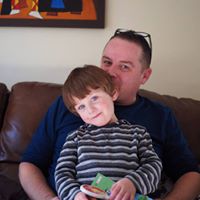Nathan P Cook
age ~50
from Danielson, CT
- Also known as:
-
- Nathan I Cook
Nathan Cook Phones & Addresses
- Danielson, CT
- 22 Frenier Ave, Attleboro, MA 02703 • 5082223992
- 22 Frenier Ave #32, Attleboro, MA 02703 • 5082223992
- 76 Linton St, Pawtucket, RI 02861 • 4017233847
- 30 Juniper Rd, North Attleboro, MA 02760
Work
-
Position:Homemaker
Education
-
Degree:High school graduate or higher
Wikipedia

Nathan Cook
view sourceNathan Cook (April 9, 1950 June 11, 1988) was an American actor. His eldest brother, Edward Cook (born December 22, 1947, died 1995) was a ballet ...
Wikipedia References

Nathan Cook (Producer)
Us Patents
-
Process For Implanting Radioactive Metal On A Substrate
view source -
US Patent:42283388, Oct 14, 1980
-
Filed:Jun 8, 1978
-
Appl. No.:5/913763
-
Inventors:Nathan H. Cook - Cambridge MA
Krishnamoorthy Subramanian - Inkster MI -
Assignee:Massachusetts Institute of Technology - Cambridge MA
-
International Classification:B23K 904
-
US Classification:219 7613
-
Abstract:A process for implanting a precise quantity of radioactive metal on a metal substrate such as a cutting tool or other metal part subject to wear at the area or areas where the part is expected to wear during its operation. The presence of the radioactive spot can be sensed to determine the extent of wear during use. The radioactive metal is deposited from a wire formed of a core of the radioactive metal surrounded by a sheath of metal having a high thermal and electrical conductivity relative to the core. In operation, the wire contacts the metal surface under pressure and electric current is passed through the wire in order to (1) form a pit on the tool surface, (2) weld the radioactive metal in the pit and (3) evaporate a small portion of the conductive sheath adjacent the pit. A second current then is passed through the wire to break it near the bottom of the pit, leaving a small quantity of radioactive material welded to the bottom of the pit.
-
Article For Implanting Radioactive Metal On A Substrate
view source -
US Patent:42860261, Aug 25, 1981
-
Filed:Aug 14, 1979
-
Appl. No.:6/066329
-
Inventors:Nathan H. Cook - Cambridge MA
Krishnamoorthy Subramanian - Inkster MI -
Assignee:Massachusetts Institute of Technology - Cambridge MA
-
International Classification:B23K 3522
B32B 1502 -
US Classification:428607
-
Abstract:A process for implanting a precise quantity of radioactive metal on a metal substrate such as a cutting tool or other metal part subject to wear at the area or areas where the part is expected to wear during its operation. The presence of the radioactive spot can be sensed to determine the extent of wear during use. The radioactive metal is deposited from a wire formed of a core of the radioactive metal surrounded by a sheath of metal having a high thermal and electrical conductivity relative to the core. In operation, the wire contacts the metal surface under pressure and electric current is passed through the wire in order to (1) form a pit on the tool surface, (2) weld the radioactive metal in the pit and (3) evaporate a small portion of the conductive sheath adjacent the pit. A second current then is passed through the wire to break it near the bottom of the pit, leaving a small quantity of radioactive material welded to the bottom of the pit.
-
Force Platform Construction And Method Of Operating Same
view source -
US Patent:43984290, Aug 16, 1983
-
Filed:May 4, 1981
-
Appl. No.:6/260040
-
Inventors:Nathan H. Cook - Cambridge MA
Forest J. Carignan - Bedford MA -
Assignee:Advanced Mechanical Technology, Inc. - Newton MA
-
International Classification:G01L 516
-
US Classification:7386204
-
Abstract:A force measuring apparatus includes a platform construction on which forces may be exerted, as for example, by an individual stepping upon a top plate of the platform construction. Apparatus of this nature is commonly referred to in the art as a "Biomechanics Platform", and may include a bottom plate, a top plate deformable by forces exerted thereon and a plurality of load cell members arranged to yieldably support the top plate in spaced relation to the bottom plate. The load cells are constructed with strain ring means having strain gage elements suitably supported thereon, and the cells further include composite anchoring means for connecting the top plate with strain rings of respective load cells in a unique manner. Each of the composite anchoring means includes a compliant or elastic member which is arranged to transmit, at any given time, an entire load exerted between the top plate and its respective load cell. Also included in each composite anchoring means are retaining elements arranged to engage with a respective elastic member as well as adjacent top plate and strain ring portions.
-
Tungsten Carbide Tools Treated With Group Ivb And Vb Metals
view source -
US Patent:40668215, Jan 3, 1978
-
Filed:Jan 22, 1976
-
Appl. No.:5/651269
-
Inventors:Nathan Henry Cook - Cambridge MA
Bruce M. Kramer - Wantagh NY -
Assignee:Massachusetts Institute of Technology - Cambridge MA
-
International Classification:C23C 1108
-
US Classification:428539
-
Abstract:Tungsten carbide tools are provided having improved wear properties which tools produce an improved surface finish on workpieces cut with said tools, both initially and after extended use. The tools are prepared by a process which comprises applying a coating of a Group IVB or VB metal of the Periodic Chart of the Elements over the tool, diffusing said metal into the tool and removing any excess of the metal from the surface of the tool, possibly by further diffusion of the metal into the tool. The preferred method is by gaseous decomposition of a metal halide in an atmosphere which does not contain a carbon source such as methane, used in some previous processes. The source of the carbon in the Group IVB or VB metal carbide is the carbon in the carbide tool being coated. Tools formed in accordance with the invention have wear properties such that they typically last at least four times as long as untreated tools and under most preferred conditions, as much as nine times as long as untreated tools.
Resumes

Manager And Merchandiser
view sourceWork:
Windmill Rice
Manager and Merchandiser
Manager and Merchandiser

Nathan Cook
view source
Nathan Cook
view source
Nathan Cook
view source
District Manager At Mbr Management Corporation
view sourceLocation:
United States
Industry:
Restaurants
Lawyers & Attorneys

Nathan Cook - Lawyer
view sourceSpecialties:
Securities & Investment Fraud
Mergers and Acquisitions
Corporate Governance
Corporate Law
General Litigation
Corporate Litigation
Securities Litigation
Mergers and Acquisitions
Corporate Governance
Corporate Law
General Litigation
Corporate Litigation
Securities Litigation
ISLN:
919062755
Admitted:
2006
University:
University of Virginia, B.A., 2002
Law School:
University of Virginia, J.D., 2005

Nathan Cook - Lawyer
view sourceISLN:
919861747
Admitted:
2008
University:
University of North Texas, B.A.
Law School:
Rutgers University, J.D.
License Records
Nathan H Cook
License #:
10678 - Expired
Issued Date:
Sep 23, 1959
Expiration Date:
Jun 30, 1990
Type:
Mechanical Engineer
Googleplus

Nathan Cook
Work:
University of Tampa - Student Manager
Sports Authority - Team Sports
Military Shopping Channel - Editor (2011)
Sports Authority - Team Sports
Military Shopping Channel - Editor (2011)
Education:
University of Tampa - Film and Media Arts
Tagline:
Cinematographer, Editor, Writer

Nathan Cook
Work:
Coublis Ltd - Consultant Developer (2012-2012)
Education:
University of Glamorgan
About:
Milk, no sugar.
Tagline:
About to finish BSc Computer Games Programming
Bragging Rights:
Guitar, Uni Survivor, Pure Geek

Nathan Cook
Work:
GoHealth Insurance - Web Developer (2012)
Andrew Lehman Design - Web Designer & Developer (2011-2012)
Andrew Lehman Design - Web Designer & Developer (2011-2012)
Education:
Minnesota State University, Mankato - Graphic Design

Nathan Cook
Work:
Redcliffe Office Supplies - Manager
Education:
Redcliffe High School
Tagline:
Only Same People Get Me

Nathan Cook
Work:
D.A.S. Diversified Inc. - Roaming Field Engineer (9)
Tagline:
"A word to the wise, is wasted. It is the idiots who need a hint.

Nathan Cook
Education:
La Trobe University - Graphic Design, St Augutines Kyabram

Nathan Cook
Work:
Thompson Wesley Wolfe, LLC - Director of Public Affairs
Education:
University of Central Florida - Political Science, BA

Nathan Cook
Work:
J. Pipkorn Home Construction - Carpenter
Youtube
Plaxo

Nathan Cook
view sourceLos Angeles, CAProvide management consulting, financial advisory, and interim management services to distressed and transitioning companies, and related stakeholders.
... Provide management consulting, financial advisory, and interim management services to distressed and transitioning companies, and related stakeholders.
Services include: Corporate turnaround and crisis management, interim management, creditor advisory, cash management, debt restructuring, asset...

Nathan Cook
view sourceDodge City, Ks.Youth Pastor at First Assembly Of God I'm 37, youth pastor for life, married, 4 kids and really happy.

Alastair Nathan Cook
view source
Alastair Nathan Cook
view source
Nathan Cook Jr.
view source
Nathan Cook Dalemans
view source
Nathan Cook
view source
Nathan Cook
view source
Nathan E. Cook
view source
Nathan Cook
view sourceGet Report for Nathan P Cook from Danielson, CT, age ~50





